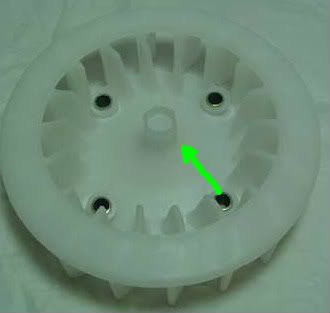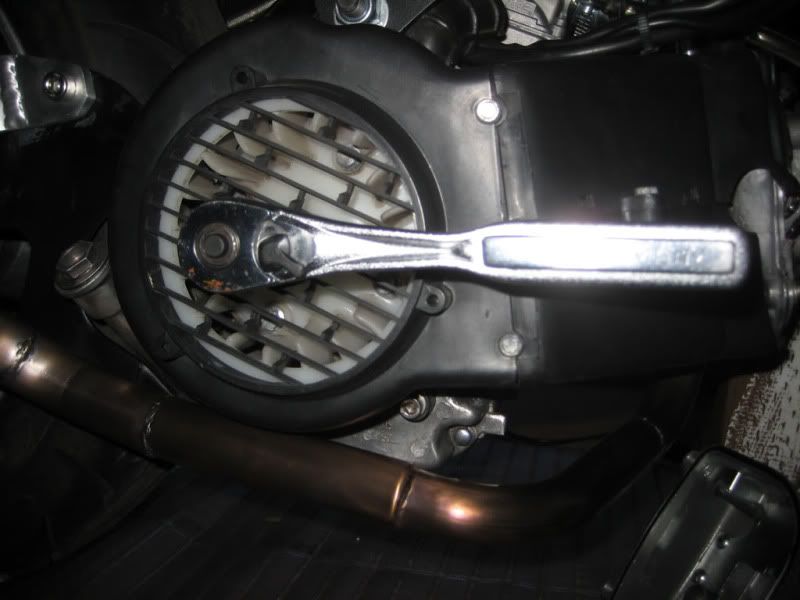|
|
Post by Fox on Jan 14, 2015 1:08:46 GMT -5
I posted a how-to a long time ago and then Brent made a video and it occurred to me tonight that the part about lining up the T mark is a waste of time. All you gotta do is rotate the engine slowly with a socket on the fan using the socket through-hole in the center of the fan cover until the cam is in the proper position and that's it! As long as the cam doesn't move then you're good to go. Some fans are 13mm and some a 14mm works better. Anyway, you don't need to remove the fan cover or even look at the T mark to adjust the valves.    |
|
|
|
Post by niz76 on Jan 14, 2015 2:52:24 GMT -5
Lol Fox- so were you just laying in bed thinking about scooters and this thought occured to you? Something about that strikes me as comical  |
|
|
|
Post by Fox on Jan 14, 2015 9:45:11 GMT -5
Actually I was looking at Brents PAIR Removal video on youtube and it occurred to me. I have been doing valves without the T mark for a looong time but it never occurred to me that it should have never been part of the procedure to begin with til last night. 49ccscoot.proboards.com/thread/428/valve-adjustment-pics-video-139qmbI'm "jmstar50". I changed my screen name to my last name (Fox) but I still have to log in as jmstar50. |
|
|
|
Post by 90GTVert on Jan 14, 2015 10:54:59 GMT -5
Why not spend the extra time doing valve adjustments to look, especially in the event that the scooter runs poorly? At least then you're checking (or double-checking if something like a BBK has just been done for example) the timing while you're at it. Popping the little round cap off of the fan shroud and peeking in should take under a minute.  If you don't like using timing marks you can use the method that works for most engines of exhaust opening and intake closing. You just need the rocker you're working with to be on the base circle of the cam. If you turn the engine over till the exhaust valve just starts to open the intake valve will be on the base circle and you can adjust it. Then you turn the engine over till the exhaust valve closes and the intake opens and almost closes. Stop a bit before the intake totally closes. Then you can adjust the exhaust valve because the cam should be on the base circle there. If you look at a cam graph or understand the idea of overlap, the reasoning behind most of this should make sense. There is a period of overlap of the exhaust and intake valves as the exhaust valve closes and the intake valve opens between the exhaust and intake strokes which should be avoided. If you set the engine so the exhaust valve is opening, it's on the leading edge of it's lobe, away from the overlap period, and the intake will be closed. If you rotate the engine so the intake valve is almost closed, then it's on the trailing edge of the intake lobe, away from the overlap period, so the exhaust valve will be closed. Even though there's plenty of rotation before the exhaust would open again, you stop before the intake closes so you can be sure you aren't rotating too far and opening the exhaust at all. That's more complex than necessary though since in our scooter engines the cam and timing marks are in plain sight while doing the valves, not buried somewhere in engine block or made more complex by multiple cylinders and firing orders. ...Or you can just set it to TDC between the compression stroke and power stroke and both valves will be closed (which is what the marks on the cam and flywheel should be telling you). All that really matters is that the valve you want to adjust is fully closed and the rocker is on the base circle of the cam. Just mentioning that stuff since sort of alternate methods are being discussed. |
|
|
|
Post by Fox on Jan 14, 2015 19:17:39 GMT -5
I really am an advocate for efficiency and if you have a good running scooter that is hard to start or you are just checking the valves cause it's been a while then there's no real need to line up the T mark. Sure, if you suspect an issue with the chain or tensioner or whatever then that's a different story...
|
|